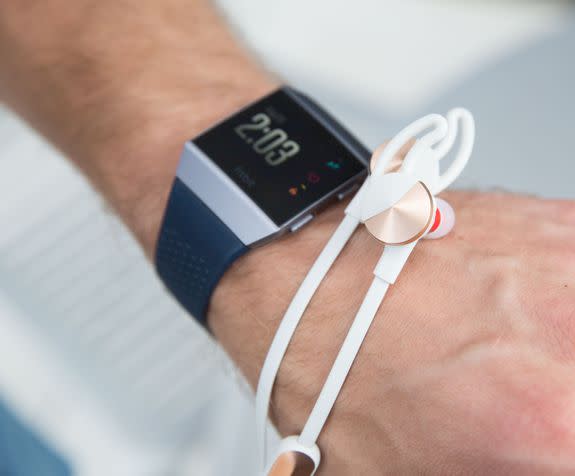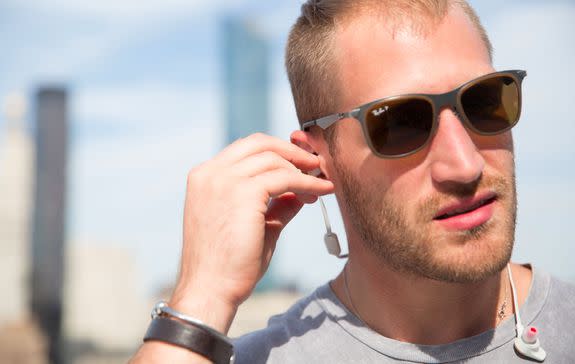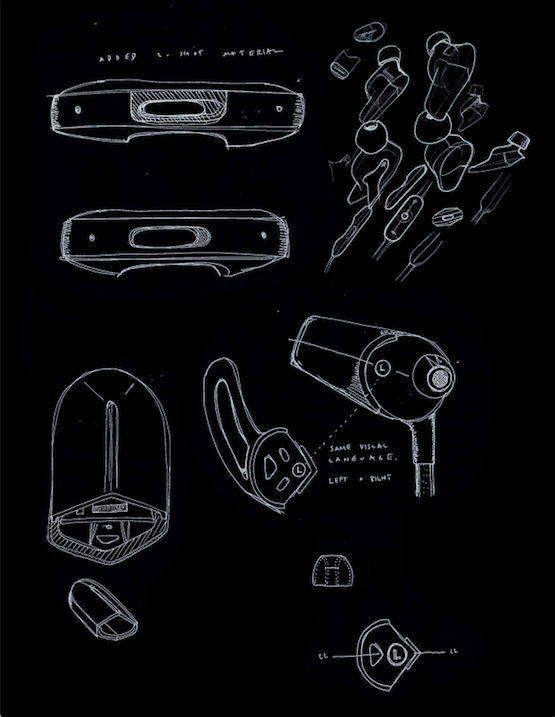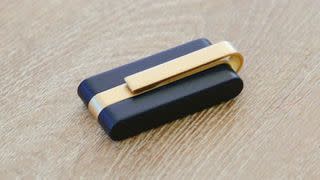Why Fitbit is making headphones now

Fitbit has a surprising new release coming out later this fall: a set of workout-ready wireless headphones called the Fitbit Flyer.
The Flyer is Fitbit's first product without any sensors or fitness-tracking features, a significant departure from the company's signature line of largely wrist-based activity trackers.
The Flyer is closely tied to the company's other big fall release, the Ionic smartwatch, which offers 2.5GB of on-device music storage and a Pandora app — so wireless headphones are a must to enjoy the tunes while you work out. The Flyer works with more devices than just the Ionic, too, and Fitbit hopes the headphones will catch on apart from the smartwatch.
The Flyer is a fairly standard set of wireless headphones (although it pairs automatically with the Ionic), though, so Fitbit is banking on its reputation in the fitness community to stand out from the countless other workout headphones on the market today.
SEE ALSO: I was a professional athlete, and even I can't make wearables useful
Fitbit gave me an inside look at the Flyer's development, which revealed some more about the headphones and where they fit within the company's larger strategy.
CEO James Park says the development team noticed that most of the wireless workout headphones on the market didn't actually perform well in the gym: some weren't as sweat-proof as advertised, while others couldn't maintain a proper fit through exercise. The development team felt that they could do better, so Fitbit set out to build a pair of its own to accompany the new smartwatch.

Image: lili sams/mashable
The Flyer team was focused on creating a product that addressed Fitbit's four main points of concern. The headphones had to be sweat-proof and durable, fit a wide range of ear shapes to stay in place during workouts, and had to connect wirelessly to multiple devices at once, so users could conceivably switch between a wearable and their smartphone for playback. The price couldn't be too high, either (the Flyer will launch at $129.95, or about $30 cheaper than Apple's AirPods) — which is partly why Fitbit left sensors out of the equation.
The company then set out on an extensive development, design, and testing process to get the headphones ready to launch alongside the Ionic, which took a bit over a year from start to finish, according to Director of Product Management Ryan Krems.
Getting developed
Once work on the Flyer was underway, Fitbit was able to test every aspect of the headphones on a wide-ranging group of willing guinea pigs: employees from across the organization, which Krems says represents a diverse spectrum of people.

Image: fitbit
The development team asked testers to run on treadmills wearing different iterations of the Flyer and even some headphones from competitors and rate the experience, just to get a baseline for the performance, no matter how tough the response. "When we’re doing those tests, we’re looking for people who haven’t been part of the [Flyer design and development] program so that you’re getting that raw, true feedback," Krems said. Since the respondents here were Fitbit employees, that feedback might not be exactly be totally unbiased — but Krems seemed pleased with the process.
The biggest challenge was getting the fit just right. Krems said there were "huge discussions internally," right up until the right up until the design was finalized.
Finding the right tone
Since Fitbit didn't have experience building audio equipment, it turned to a new partner to help with the Flyer's sound. Waves Audio, a company known best for its high-end studio equipment, was tapped to give the Flyer some extra thump.
Waves had never made a set of wireless headphones either, but the company's engineers worked closely with Fitbit's over the course of several months to fine-tune the sound, according to Fitbit Director of Marketing Michael Polin. The Flyer's Power Boost sound feature, which Polin claims can pump out higher bass and more amplified sound in a smaller package than other earphones, was a direct result of the collaboration.

Image: lili sams/mashable
I was pleasantly surprised by my first impressions of the Flyer's sound. The bass comes across deeper and richer than in some of the other exercise-first headphones I've used, and the quality of the audio doesn't flag at high or low volume.
Design cues
Jonah Becker, Fitbit's head of design and the former design chief at HTC, created a brand new profile for the Flyer, which has a distinctive "wing" that keeps the earbuds flush to the wearer's head, or an optional fin attachment that wraps more snugly into the ear.

Image: fitbit
The first step in Becker's process for creating the Flyer was designing something distinctive, yet widely applicable. That's where the wing shape came into play.

Image: fitbit
"We wanted to have a couple different variations because one design in multiple sizes doesn’t necessarily address the broadest range of people," he said. The wing nests inside the upper ear, instead of wrapping inside, which Becker thinks provides a more universal fit.
Flying forward
CEO Park says the Flyer's release doesn't necessarily mean Fitbit will be making more hardware outside of the company's calling card, activity tracking. That’s the main focus for Fitbit moving forward — but within that fitness-first structure, he stressed that there's room for other opportunities as they arise.
The Flyer is the first of those opportunities, so for Fitbit's sake, hopefully someone is listening.
WATCH: This device can make any pair of headphones wireless

